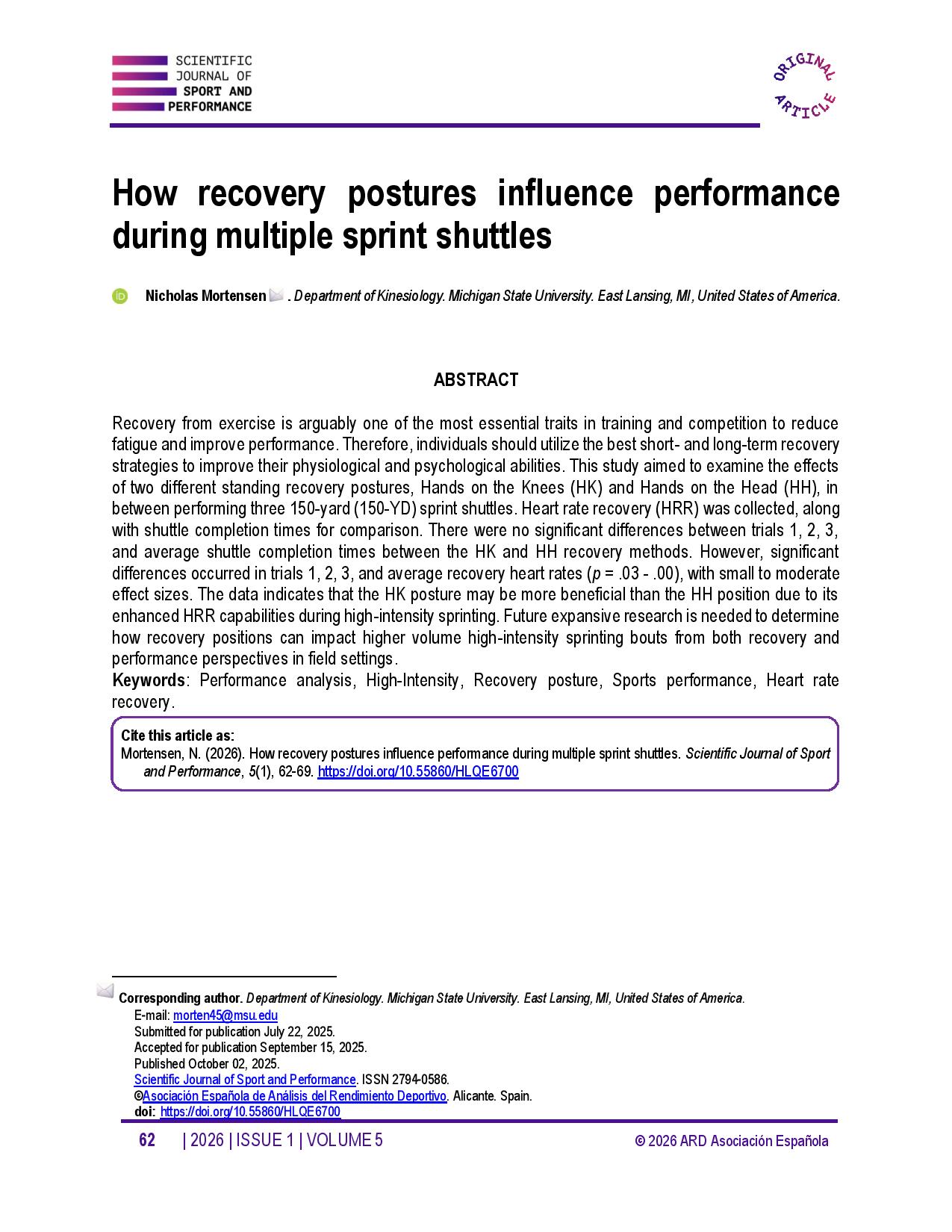How recovery postures influence performance during multiple sprint shuttles
Main Article Content
Abstract
Recovery from exercise is arguably one of the most essential traits in training and competition to reduce fatigue and improve performance. Therefore, individuals should utilize the best short- and long-term recovery strategies to improve their physiological and psychological abilities. This study aimed to examine the effects of two different standing recovery postures, Hands on the Knees (HK) and Hands on the Head (HH), in between performing three 150-yard (150-YD) sprint shuttles. Heart rate recovery (HRR) was collected, along with shuttle completion times for comparison. There were no significant differences between trials 1, 2, 3, and average shuttle completion times between the HK and HH recovery methods. However, significant differences occurred in trials 1, 2, 3, and average recovery heart rates (p = .03 - .00), with small to moderate effect sizes. The data indicates that the HK posture may be more beneficial than the HH position due to its enhanced HRR capabilities during high-intensity sprinting. Future expansive research is needed to determine how recovery positions can impact higher volume high-intensity sprinting bouts from both recovery and performance perspectives in field settings.
Article Details

This work is licensed under a Creative Commons Attribution-NonCommercial-ShareAlike 4.0 International License.
References
Buchheit, M., Al Haddad, H., Laursen, P.B. and Ahmaidi, S. (2009), Effect of body posture on postexercise parasympathetic reactivation in men. Experimental Physiology, 94: 795-804. https://doi.org/10.1113/expphysiol.2009.048041 DOI: https://doi.org/10.1113/expphysiol.2009.048041
Burnley, M. & Jones, A. M. (2016). Power-duration relationship: Physiology, fatigue, and the limits of human performance. European Journal of Sport Science, 18(1), 1-12. https://doi.org/10.1080/17461391.2016.1249524 DOI: https://doi.org/10.1080/17461391.2016.1249524
Charry, D., Wang, T., McLaurin, N., Leelartapin, K., Ponlasen, S., Suksom, D., & Tanaka, H. (2023). Effectiveness Of Different Recovery Postures During High-intensity Interval Training. Medicine & Science in Sports & Exercise, 55(9S), 686. https://doi.org/10.1249/01.mss.0000986280.79928.9e DOI: https://doi.org/10.1249/01.mss.0000986280.79928.9e
Halson, S.L. (2014). Recovery techniques for athletes. Gatorade Sports Science Institute. Retrieved from [Accessed 2025, 24 September]: https://www.gssiweb.org/en/sports-science-exchange/Article/sse-120-recovery-techniques-for-athletes
Hoffman, J.R. (2012). NSCA's guide to program design. Champaign: Human Kinetics.
Hureau, T. J., Broxterman, R. M., Weavil, J. C., Lewis, M. T., Layec, G., & Amann, M. (2022). On the role of skeletal muscle acidosis and inorganic phosphates as determinants of central and peripheral fatigue: A 31 P-MRS study. The Journal of Physiology, 600(13), 3069-3081. https://doi.org/10.1113/JP283036 DOI: https://doi.org/10.1113/JP283036
Hwangbo, G., Lee, D. H., Park, S. H., & Han, J. W. (2017). Changes in cardiopulmonary function according to posture during recovery after maximal exercise. Journal of Physical Therapy Science, 29(7), 1163-1166. https://doi.org/10.1589/jpts.29.1163 DOI: https://doi.org/10.1589/jpts.29.1163
Lamberts, R.P., Swart, J., Capostagno, B., Noakes, T.D. & Lambert, M.I. (2010). Heart rate recovery as a guide to monitor fatigue and predict changes in performance parameters. Scandinavian Journal of Medicine & Science in Sports, 20, 449-457. https://doi.org/10.1111/j.1600-0838.2009.00977.x DOI: https://doi.org/10.1111/j.1600-0838.2009.00977.x
Michaelson, J.V., Brilla, L.R., Suprak, D.N., McLaughlin, W.L., & Dahlquist, D.T. (2019). Effects of two different recovery postures during high-intensity interval training. Translational Journal of the ACSM, 4(4), 23-27. https://doi.org/10.1249/TJX.0000000000000079 DOI: https://doi.org/10.1249/TJX.0000000000000079
Thomas, J. R., Nelson, J. K., & Silverman, S. J. (2015). Research methods in physical activity (7th ed.). Human Kinetics.
White, K., DeBeliso, M., Sevene, T., & Adams, K. (2015). The reliability of the 300-yard shuttle run in high school girls basketball players. Journal of Sports Sciences, 3, 214-218. https://doi.org/10.17265/2332-7839/2015.05.002 DOI: https://doi.org/10.17265/2332-7839/2015.05.002




